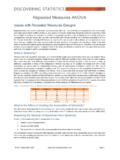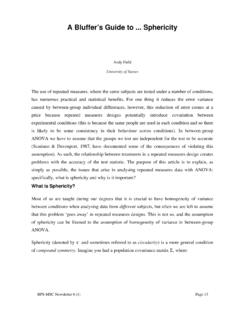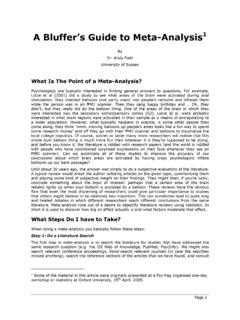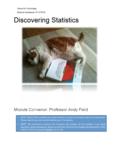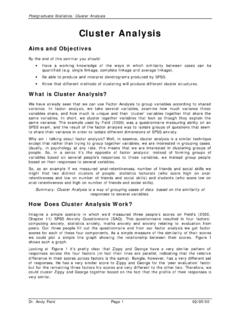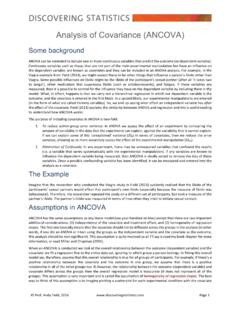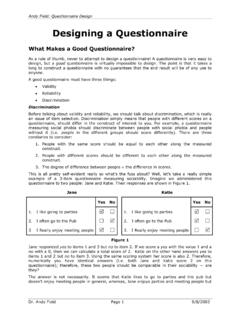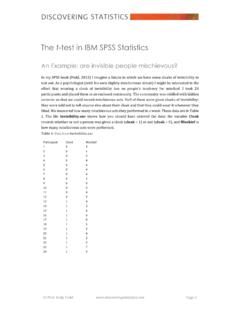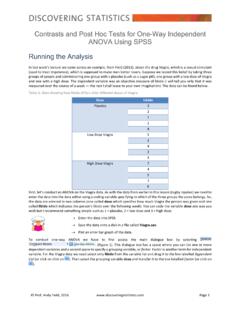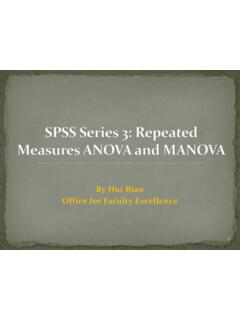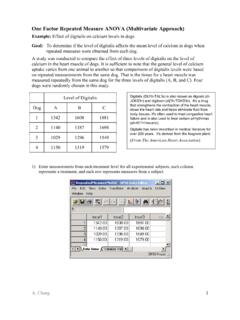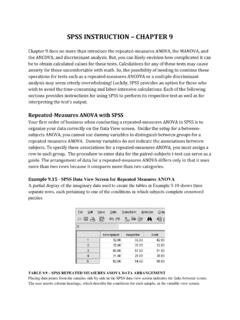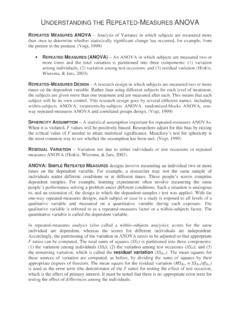Transcription of OneWayANOVA Repeated Measures - Discovering …
1 C8057 (Research Methods 2): One Way Repeated Measures ANOVA by Hand Dr. Andy Field, 2000 Page 1 One-Way Repeated Measures ANOVA by Hand Repeated Measures vs. Between-group designs When we collect data, we choose between two methods of data collection. The first is to manipulate the independent variable using different participants: so, different groups of people take part in each experimental condition (a between-group or between-subjects design). The second method is to manipulate the independent variable using the same participants.
2 Simplistically, this method means that we test the same group of participants in all experimental conditions (a within-subject or Repeated Measures design). The way in which the data are collected determines the type of test that is used to analyze the data. Just like the t-test, there are different versions of ANOVA designed to deal with Repeated Measures designs. The rationale for ANOVA is the same regardless of whether the data are collected using a between-group or a Repeated Measures design.
3 That is, we carry out some experimental manipulation. We expect this manipulation to create variation in scores across conditions (systematic variation). However, we also expect there to be variation caused by individual difference in performance and other random factors that we cannot account for (unsystematic variation). In the ANOVA we want to work out how much variation there is in total and then calculate how much of this variation was caused by our experimental manipulation and how much is due to other factors.
4 Repeated Measures ANOVA If we stick to a simple example in which there are only two experimental conditions and a Repeated Measures design has been used, the same participants participate in both conditions. So, we measure subject s behaviour in condition 1 and in condition 2. If there is no experimental manipulation then we expect a person s behaviour to be roughly the same across conditions. We expect this because external factors such as age, gender, IQ, motivation and arousal will be the same in every condition (a person s gender etc.)
5 Will not change from when they are tested in condition 1 to when they are tested in condition 2). If the performance measure is reliable, and the variable or characteristic that we are measuring remains stable over time, then it is probable that a subject s performance in condition 1 will be very highly related to their performance in condition 2. So, participants who score highly in condition 1 will also score highly in condition 2. When we introduce an experimental manipulation, we do something different to participants in condition 1, to what we do to them in conditions 2.
6 So, the only difference between conditions 1 and 2 is the manipulation that the experimenter has made. Therefore, any differences between the means of the two conditions are probably due to the experimental manipulation. Of course humans are not robots (well, apart from statistics lecturers) and so a person s performance would not be identical across conditions if there were no experimental manipulation. As such, when we look at the variation caused by our experimental manipulation, we still need to be aware that some of that variation will be caused by unknown factors.
7 As such, in Repeated Measures ANOVA we have to look at the variation across conditions for a given participant (as a measure of the effect of our experiment) but also gauge the error within that variance. Benefits of Repeated Measures Designs Sensitivity: The effect of our experimental manipulation is likely to be more apparent in a Repeated Measures design than in a between-group design because in the former unsystematic C8057 (Research Methods 2): One Way Repeated Measures ANOVA by Hand Dr. Andy Field, 2000 Page 2 variation can be caused only by differences in the way in which someone behaves at different times.
8 In between-group designs we have differences in innate ability contributing to the unsystematic variation. Therefore, this error variation will almost always be much larger than if the same participants had been used. When we look at the effect of our experimental manipulation, it is always against a background of noise caused by random, uncontrollable differences between our conditions. In a Repeated Measures design this noise is kept to a minimum and so the effect of the experiment is more likely to show up. This means that Repeated Measures designs have more power to detect effects that genuinely exist than independent designs.
9 Economy: Repeated Measures designs make more efficient use of participants and so save time and money. However, although in theory you could have a participant take part in many different conditions, they do tend to get very bored and frustrated in long experiments. Therefore, it s always worth trying to bear in mind what your participants will have to endure before designing an experiment with 250 different experimental conditions Disadvantages of Repeated Measures Designs If the same people participate in more than one experimental condition, although they are naive during the first experimental condition they come to the second experimental condition with prior experience of what is expected of them.
10 At the very least they will be familiar with the dependent measure . The two most important sources of systematic variation in this type of design are: Practice effects: Participants may perform differently in the second condition because of familiarity with the experimental situation and/or the Measures being used. Boredom: Participants may perform differently in the second condition because they are tired or bored from having completed the first condition. Although these effects are impossible to eliminate completely, we can ensure that they produce no systematic variation between our conditions.
